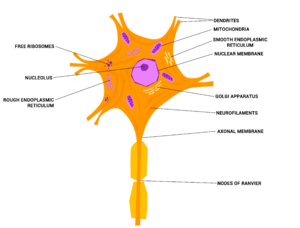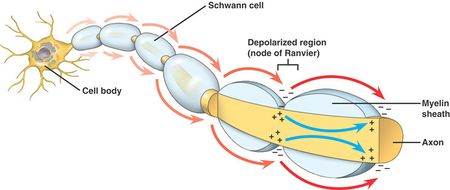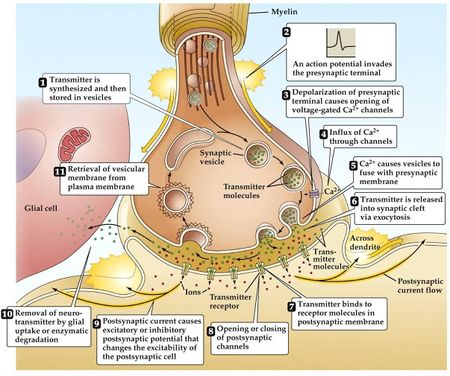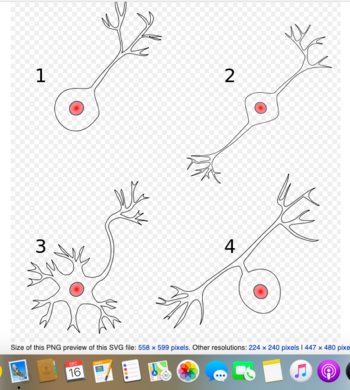Neurones are cells of the central nervous system, located within the grey matter, and responsible for all neurological functions of the brain.
- Every person’s body contains billions of neurones. There are about 100 billion in the brain and 13.5 million in the spinal cord.
- The fastest signal transmission in the body occurs in the alpha motor neurons within the spinal cord. They transmit a signal at 431 km per hour. The slowest signal transmission is within the skin at 1.6 km per hour.
- We lose neurons as we age, starting at around 20 years old in humans. 1/10 of our neurones are gone by the time we turn 75 and our brain shrinks by about 1-2 grams every year due to the loss of neurones.
- The longest nerve in the body is the sciatic nerve. It runs from the spinal cord to the toes on each side of the body.
- Glial cells are support cells for neurones. They make myelin to surround part of the neuron and can also get rid of microbes and help supply nutrients to the neurones.
- Neurones do not go through mitosis, and usually cannot be replaced after being destroyed, although astrocytes have been observed to turn into neurones as they are sometimes pluripotent.
3 types of Neurones exist and are programmed to do different things.
- Motor neurones carry signals from the CNS to the outside parts of the body. See Link
- Sensory Neurons: The sensory neurones are the portion of the nervous system responsible for processing input from the environment. Beginning with detection through the transfer of stimuli to the central nervous system, the peripheral nerves and their associated receptors rapidly relay information. The peripheral nervous system consists of the somatosensory nervous system and autonomic nervous system: The sensory pathway of the somatosensory system involves spinal nerves which transmit information about the external environment to the spinal cord; The autonomic nervous system has visceral sensory neurons which are responsible for monitoring the internal environment and eliciting appropriate changes in effector organs to maintain homeostasis (visceral sensory nerves transmit pain, stretch, temperature, and chemical change in visceral organs which gets interpreted as sensations like nausea, hunger, gas, cramping, etc).
- Interneurons sends messages from one neurone to another.
Structure
Neurones vary in morphology and size substantially, but all share a number of features :
 |
| Neuron |
Cell body
- Contains the nucleus and is the site of synthesis of virtually all neuronal proteins and membranes. Some proteins are synthesized in dendrites, but no proteins are made in axons and axon terminals, which do not contain ribosomes. Proteins and membranes that are required for renewal of the axon and nerve termini are synthesized in the cell body and assembled there into membranous vesicles or multiprotein particles.
- Perikaryon: cytoplasm surrounding the nucleus
 |
| Axon |
Axon
- Generally the 'output' of the neurone
- Specialized for the conduction of a particular type of electric impulse, called an action potential, outward, away from the cell body toward the axon terminus. An action potential is a series of sudden changes in the voltage, or equivalently the electric potential, across the plasma membrane. When a neuron is in the resting (nonstimulated) state, the electric potential across the axonal membrane is approximately −60 mV (the inside negative relative to the outside); the magnitude of this resting potential is similar to that of the membrane potential in most non-neuronal cells. At the peak of an action potential, the membrane potential can be as much as +50 mV (inside positive), a net change of ≈110 mV. This depolarization of the membrane is followed by a rapid repolarization, returning the membrane potential to the resting value. These characteristics distinguish an action potential from other types of changes in electric potential across the plasma membrane and allow an action potential to move along an axon without diminution.
- Single process of variable length (even over a metre)
- Axonal transport: the transportation of materials along the axon of a neuron via the flow of the jellylike fluid (axoplasm) it contains. Transport may be directed away from the cell body (anterograde) or back toward the cell body (retrograde). Also called axoplasmic flow. Carried out by proteins such as kinesin and dynein.
- Terminates in terminal buttons which release neurotransmitters
- Most of the volume of our brain is occupied by axons, which form a complex network called white matter. Like a maze of airways linking cities around the world, white matter manages communication and co-ordination between the various areas where populations of neurons process information. These areas are located in different parts of the brain, sometimes close to each other, sometimes far away: this is the principle of distributed computing.
Dendrites
- Generally the 'input' of the neurone
- Most neurons have multiple dendrites, which extend out-ward from the cell body and are specialized to receive chemical signals from the axon termini of other neurons. Dendrites convert these signals into small electric impulses and transmit them inward, in the direction of the cell body. Neuronal cell bodies can also form synapses and thus receive signals
- Particularly in the central nervous system, neurons have extremely long dendrites with complex branches. This allows them to form synapses with and receive signals from a large number of other neurons, perhaps up to a thousand.
- Electric disturbances generated in the dendrites or cell body spread to the axon hillock. If the electric disturbance there is great enough, an action potential will originate and will be actively conducted down the axon.
Synapses
 |
| Synapse |
Information from one neuron flows to another neuron across a synapse. The synapse contains a small gap separating neurons. The synapse consists of:
- A presynaptic ending that contains neurotransmitters, mitochondria and other cell organelles. At the presynaptic ending an electrical impulse will trigger the migration of vesicles containing neurotransmitters toward the presynaptic membrane. The vesicle membrane will fuse with the presynaptic membrane releasing the neurotransmitters into the synaptic cleft.
- A synaptic cleft or space between the presynaptic and postsynaptic ending.
- A postsynaptic ending that contains receptor sites for neurotransmitters. The neurotransmitter molecules diffuse across the synaptic cleft where they can bind with receptor sites on the postsynaptic ending. When a neurotransmitter binds to a receptor on the postsynaptic side of the synapse, it changes the postsynaptic cell's excitability: it makes the postsynaptic cell either more or less likely to fire an action potential. If the number of excitatory postsynaptic events is large enough, they will add to cause an action potential in the postsynaptic cell and a continuation of the "message."
Many psychoactive drugs and neurotoxins can change the properties of neurotransmitter release, neurotransmitter reuptake and the availability of receptor binding sites.
Types of neurones
 |
| 1: Unipolar neuron 2: Bipolar neuron 3: Multipolar neuron 4: Pseudounipolar neuron |
Three main morphological patterns of neurones are described, depending on the relationship of the cell body to the axon and dendrites.
- Multipolar neurons: most common type of neuron. They are located in the central nervous system (brain and spinal cord) and in autonomic ganglia. Multipolar neurons have more than two processes emanating from the neuron cell body.
- Bipolar: relatively rare. They are sensory neurons found in olfactory epithelium, the retina of the eye, and ganglia of the vestibulocochlear nerve.
- Unipolar/pseudounipolar: sensory neurons with cell bodies located in spinal and cranial nerve ganglia. (Note: unipolar neurons are sometimes called pseudo-unipolar because embryologically they originate as bipolar neurons and subsequently become unipolar.)
Neural Circuits
The 1.4 kg of jelly-like material found within our skulls is the most complex machine on Earth and perhaps the universe. Its phenomenal features would not be possible without the hundreds of billions of neurons that make it up, and, importantly, the circuits between those neurons.
- Nerve cells that carry information toward the central nervous system (or farther centrally within the spinal cord and brain) are called afferent neuronsNeurons never function in isolation; they are organized into circuits that process specific kinds of information. Although the arrangement of neural circuits varies greatly according to the intended function, some features are characteristic of all such circuits.
- The synaptic connections that define a circuit are typically made in a dense tangle of dendrites, axons terminals, and glial cell processes that together constitute neuropil (the suffix -pil comes from the Greek word pilos, meaning “felt”).
- The neuropil between nerve cell bodies is the region where most synaptic connectivity occurs.
- The direction of information flow in any particular circuit is essential to understanding its function. Three classes of neurons are the basic constituents of all neural circuits.
- Nerve cells that carry information away from the brain or spinal cord (or away from the circuit in question) are called efferent neurons.
- Nerve cells that only participate in the local aspects of a circuit are called interneurons or local circuit neurons.
Considerable progress has been made in understanding how different simple neural networks are involved in information processing and mediating behavior. Feedforward excitation and feedforward inhibition mediate reflex behaviors. Lateral inhibition is important for edge enhancement. Recurrent excitation is an important mechanism for memory. Recurrent inhibition can be important for generating locomotor behavior. Convergence and divergence are embedded in these microcircuits. The same kinds of network motifs are recapitulated in biochemical and gene networks.
A simple example is the circuit that subserves the myotatic (or “knee-jerk”) spinal reflex. See Image above: This figure shows the monosynaptic reflex pathway stimulating muscle contraction and the di-synaptic reflex inhibiting contraction of the antagonistic muscle.
The next level of understanding is at the level of the neuronal networks that mediate more complex ie higher-order functions of the brain.
Their understanding is becoming possible through the use of electrophysiological and optical recording techniques, and modern imaging techniques such as functional magnetic resonance imaging (fMRI) and diffusion tensor imaging (DTI). fMRI allows investigators to identify areas of the brain that are engaged in cognitive tasks, whereas DTI allows visualization of pathways linking one brain region to another.
Neuropathy
Neurone Wound Healing
The peripheral nerves connect the brain and spinal cord to the rest of the body. Peripheral neuropathy is a relatively common neurological disorder that can occur as the result of a wide range of underlying conditions or diseases. Diabetes is perhaps the most common – approximately 50 per cent of diabetics suffer from diabetic neuropathy.
Injured nerves should be repaired as early as possible (waiting until the metabolic environment has been maximized has no advantages).
The current criterion standard technique of repair remains epineurial suture approximation of transected nerves with fine monofilament suture with interposition grafting using an autologous nerve if a tensionless repair cannot be achieved.
Factors influencing nerve healing potential following repair include:
- Age: the most important factor. Younger patients have more positive outcomes (compared to adults) and the recovery time is quicker. Studies have shown that, even in the pediatric population, patients < 6 years of age recovery more quickly compared to their adolescent counterparts
- Level of injury: distal injuries have a better chance of recovery compared to more proximal injuries
- Injury pattern: sharp lacerations/transections do better than crush injuries
- Delay in repair: chronic injuries do poorly
- Secondary tissue damage occurs with excessive handling; Nerve endings should be properly aligned (and not under tension) during a direct repair; Excessive suture material used during the repair risks the development of a neuroma at the site of repair.
Neurodegenerative Disorders
Many conditions can affect neurons and their transmission. Some of these include neurodegenerative diseases eg Motor Neurone Disease (MND), some dementias, Huntington disease, spinal and bulbar muscular atrophies, as well as lesions of the motor neurons.
Many neurodegenerative conditions, from glaucoma to Alzheimer's disease, are characterized by injury to axons. Injury to axons often leads to neuronal impairment and cell death.
Adult Neurogenesis
"Adult neurogenesis" refers to the ability of the central nervous system (brain and spinal cord) to generate new neurons in adulthood called adult generated neurons. See link
Summary
- Cell body of a neuron contains the nucleus and lysosomes and is the site of synthesis and degradation of virtually all neuronal proteins and membranes.
- Axons are long processes specialized for the conduction of action potentials away from the neuronal cell body.
- Action potentials are sudden membrane depolarizations followed by a rapid repolarization. They originate at the axon hillock and move toward axon terminals, where the electric impulse is transmitted to other cells via an electric or chemical synapse.
- Most neurons have multiple dendrites, which receive chemical signals from the axon termini of other neurons.
- When an action potential reaches a chemical synapse, a neurotransmitter is released into the synaptic cleft. Binding of the neurotransmitter to receptors on the postsynaptic cell changes the ion permeability and thus the electric potential of the postsynaptic plasma membrane.
- Neurons are organized into circuits. In a reflex arc, such as the knee-jerk reflex, interneurons connect multiple sensory and motor neurons, allowing one sensory neuron to affect multiple motor neurons. One muscle can be stimulated to contract while another is inhibited from contracting

0Comments